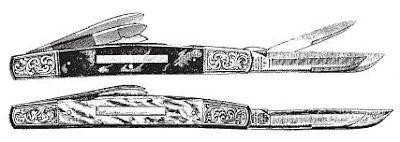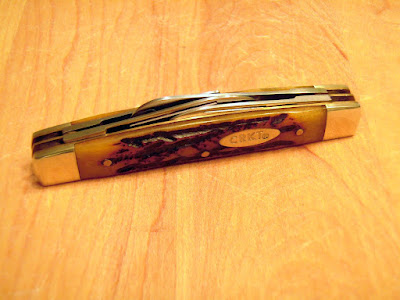There is a very distinctive pocket knife pattern known as the 'congress pattern'. It has been around since the mid-1800s. Lots of folks on hearing the name assume it is somehow directly linked to the US Congress. Perhaps it was a style of knife officially adopted by Congress? Or presented by Congress on special occasions? That is nice to think about - our august and beneficent Congress officially adopting a knife. Unfortunately there is no record I can find proving that Congress ever officially adopted anything with a sharp edge on it. The true story behind the congress pattern knife seems to be more of a self-fulfilling wish.
In the early 1800s the cutlery firms out of Sheffield, England were pouring knives and cutlery products into the young United States to fulfill an almost insatiable demand for quality blades. At the time the US was still an agrarian society and was expanding fast, first up over the Appalachians and into the old Northwest Territories (the upper midwest), then into the Louisiana Purchase. Land was cheap and fertile and a hardworking family could easily support themselves on a modest sized farm. There were few labor saving devices in those days and everything on the farm was done by hand or horse power. Most farm tasks involved a cutting edge - a knife, axe, saw, even a plow blade. Local blacksmiths and small manufacturers in the eastern US handled the 'rough trade' implements; axes, hatchets, butcher knives, saw blades, etc., but there was still a demand for finer cutlery that American manufacturers couldn't meet - quality kitchen cutlery, fine hunting knives and well made pocket knives. This is the market the Sheffield cutlers dominated. Sheffield cutlery had an almost mystical reputation; English crucible steel was the best production steel available at the time and Sheffield's skilled workforce could turn out an amazing range and volume of high quality knives and tools to meet specific needs. The blade stamp 'Sheffield' was considered a hallmark of superior quality and American customers selected Sheffield products before all others.
The cutlery firms of Sheffield were also marketing geniuses. Lets face it, the average 19th century farm laborer or office clerk really only needed one pocket knife in his life - something to cut up his lunchtime slab of roast beef or ham and to whittle a new nib on his quill pen. A pocket knife was a durable consumer item - something that didn't wear out in use and lasted years or decades. The Sheffield firms needed to convince consumers that they just HAD to have a new knife long before the old one wore out - they needed to build steady, repeat demand. The cutlery firms hit on a brilliant marketing gimmick - the concept of the cosmetic upgrade.
More than a century before the marketing wizards of Detroit put the same plan into action, the cutlery firms of Sheffield figured out that if you gussy up a plain knife just a bit - add mother of pearl handles or silver bolsters, or put a better polish on the blade - they could more readily catch the eye of the young dandy who was doing a little window shopping. Maybe he was tired of looking at the old, scuffed up wooden handled knife he carried around in his pocket and that new, shiny, fancy knife was just what he needed to impress his girl. It was all eye candy appeal, and damn if it didn't work!
Then they took it to the next level. The Sheffield firms hit on the idea of generating the perception that specific tasks demanded very specific cutting blade styles. Any old pocket knife can slice open a letter, but the cutlers of Sheffield implied that only a specially designed desk knife with a letter opening blade can get the job done done with elegance and style. No true gentleman should ever be caught opening important correspondence with a plain old pocket knife. It was undignified! Similarly, while any old pocket knife can slice up a pear or an apple the cutlers of Sheffield impressed upon their scruffy American cousins the notion that only a knife with a specially designed blade is suitable to the elegant task of carving up the dessert fruit. It would be just so ungentlemanly to let your lady see you slice up those delicate grapes with the same pocket knife you used to clean your fingernails. Only a specially designed Sheffield fruit knife was correct for the task. Oh, you unwashed masses! You have so much to learn (and so much money to spend). Let the master cutlers of Sheffield bring elegance and orderliness into your lives!
The 19th century cutlery catalogs put out by the Sheffield firms show a bewildering array of knives. The combinations of blade styles and finishes are endless. Pocket knives for camping, cooking, carving and castrating. Doctor's pocket knives for doing emergency surgery. Whittling knives for turning big sticks into little sticks. Pruning knives for tending the garden. Farriers knives with a folding pick for cleaning your horse's hooves. Delicate little bird knives that slip comfortably into the vest pocket on upland game hunts. Knives for cutting tobacco leaf and knives for clipping the end off of a fine cigar.
Out of this crazy mix of blade styles and finishes emerged the knife known as the 'congress pattern'. It appears the name was merely a marketing device first used by Joseph Rodgers & Sons sometime before the mid-1800s. It was originally a four blade knife with edges suited for shaping pen nibs and carving and whittling. I guess the marketing guys at Joseph Rodgers figured that's all that American congressmen did with their time - whittle on wooden sticks and sharpen quill pen nibs. Thus the congress pattern knife was born.
 |
| Joseph Rodgers & Sons congress pattern pocket knife. From a late 19th century cutlery catalog. |
A funny thing happened on the way to the Capitol Building. The knife proved so popular that people naturally assumed the congress pattern was what congressmen carried and that it was somehow endorsed by the US Congress. After all, who wouldn't want to own the very same knife that their local congressman carried? It helped that it was also a very good design with a great combination of useful blades. In one of the classic examples of advertising shaping reality a lot of congressmen - senators and representatives - ended up carrying and using the congress pattern knife. In fact, one of America's greatest presidents and an acknowledged knife and gun enthusiast regularly carried this knife. No, not Teddy Roosevelt. Abraham Lincoln! The night he was assassinated in Ford's Theater he had a congress pattern knife in his pocket. That knife is now on display in the Library of Congress.
 |
| The contents of Abraham Lincoln's pockets on the night he was assasinated at Ford's Theater. Note the distinctive congress pattern pocket knife. From the Library of Congress 'Artifacts of Assassination' on-line display |
[Editorial aside here. Yes Virginia, Abraham Lincoln was a big gun and knife enthusiast. He loved reviewing new weapons patents and often invited gun makers to demonstrate their new inventions right on the grounds of the White House. He was fascinated by the Henry Rifle design and pushed the War Department to adopt it during the Civil War. That was probably the last time a gun was fired for sport or pleasure on the grounds of the White House.]
A question that is often asked is whether or not the congress pattern knife was ever sold in the gift shops in the US Capitol Building. I don't think anyone can say for sure, but what we do know is that right up through the early 1980s various commemorative pocket knives were offered for sale in the gift shops. While visiting the Capitol on several occasions in the early 80's I clearly remember seeing pocket knives for sale. In his classic book 'The Practical Book of Knives' the author Ken Warner shows a Schrade Uncle Henry stockman pattern knife he bought in the Senate shop in the Capitol. So, I think it's a fair assumption to say that at some point a congress pattern knife was offered for sale in the US Capitol. But those days are far behind us. I'm sure that today in a building filled with dull minds there are no sharp things on offer.
While not as popular as it once was, the congress pattern knife is still available from a number of manufacturers. Case Cutlery, the premier US pocket knife manufacturer, offers several styles in their current catalog. It is a good pattern and it still sells well.
Recently I came across a congress pattern knife offered by CRKT (Columbia River Knife and Tool). I've owned several of their other pocket knife offerings and they are all very well done. I decided to order one up and when it arrived I became fascinated by the knife's design and history (and hence this blog post!).
 |
| The CRKT Congress Pattern Knife |
 |
| Blades out! An extremely useful combination of blades. No wonder this pattern was so popular. |
Stay sharp!
Brian

Love the pattern, but different blade types are in order. Dad (a great knife fancier and WW2 hero) loved the congress pattern. The only thing that I would change would be a main Clip point blade and other types.
ReplyDelete